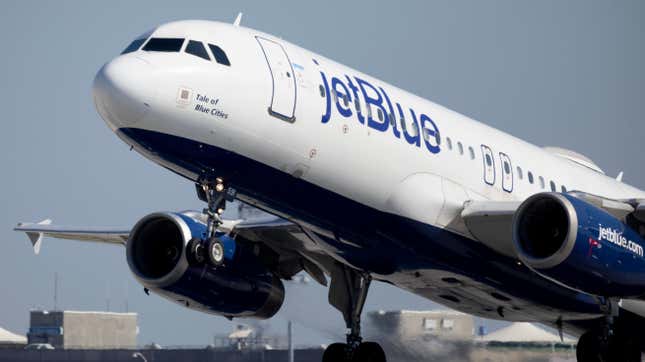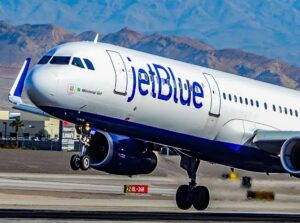
JetBlue Airways (JBLU) is moving forward with plans to take on substantial new debt despite the recent turbulence caused by its failed merger with Spirit Airlines. According to a Bloomberg report, the airline is preparing to accumulate $2.75 billion in new financial obligations as it seeks to navigate the aftermath of the abandoned deal.
However, this decision is not being received well by all parties involved. Both credit rating agencies and equity investors have expressed concerns about the airline’s financial health. JetBlue’s stock took a significant hit, plummeting over 20% during Monday’s trading session. Adding to the airline’s woes, both S&P and Moody’s downgraded JetBlue’s default risk rating, pushing it further into speculative-grade, commonly known as “junk bond” status.

The bulk of the collateral for this new debt will come from JetBlue’s frequent flyer program, which the airline sees as a valuable asset. Speaking at an investment conference in March, CEO Ursula Hurley reflected on the failed Spirit Airlines merger, describing it as “three years of distraction.” She also hinted at the airline’s plans to leverage its loyalty program as a financial strategy.
“We have $10 billion of unencumbered assets and about half of the $10 billion is our loyalty program,” Hurley explained. “We’re one of the only airlines out there that hasn’t yet levered up the loyalty program.”
Airlines like JetBlue generate revenue from their frequent flyer programs by selling points to various businesses, including hotels and credit card companies. Last year, JetBlue earned over $400 million through such points sales, according to its annual financial report.

JetBlue’s decision to take on new debt highlights the airline’s determination to move forward despite the setbacks from the failed Spirit Airlines merger. The merger, which was initially seen as a potential game-changer for both airlines, faced multiple regulatory and operational hurdles that ultimately led to its collapse. JetBlue’s leadership, however, remains committed to charting a course for the airline’s future, even if it means taking on more debt in the short term.
The decision to use the airline’s frequent flyer program as collateral is a strategic move, albeit one that comes with risks. Frequent flyer programs are highly valuable to airlines, serving as a key revenue stream and a way to build customer loyalty. However, leveraging such an asset for debt can be a double-edged sword. While it provides immediate financial support, it also ties up a significant portion of the airline’s assets, potentially limiting its financial flexibility in the future.
Investors and analysts have expressed concerns about JetBlue’s decision to take on more debt, especially in light of the recent downgrade in its credit rating. The downgrade reflects growing concerns about the airline’s ability to manage its debt load and maintain its financial health. Speculative-grade ratings indicate a higher risk of default, which could lead to higher borrowing costs and reduced investor confidence.
Despite these challenges, JetBlue’s leadership appears confident in its ability to navigate the current financial landscape. CEO Ursula Hurley’s remarks at the investment conference suggest that the airline is focused on leveraging its existing assets to secure its financial future. By using the frequent flyer program as collateral, JetBlue is betting that it can generate enough revenue to service its debt and continue its operations without compromising its long-term growth potential.
However, the decision to take on new debt is not without its critics. Some industry analysts have questioned whether JetBlue is taking on too much risk by leveraging its loyalty program. While the program is undoubtedly valuable, using it as collateral means that the airline is betting on its continued success to meet its financial obligations. If the program’s value declines or if the airline faces further financial difficulties, JetBlue could find itself in a precarious position.
The failed merger with Spirit Airlines has undoubtedly left JetBlue in a challenging position. The merger, which was initially seen as a way for both airlines to expand their market share and compete with larger carriers, ultimately proved too difficult to execute. The collapse of the deal has left JetBlue with significant costs and legal obligations, further complicating its financial situation.
In the wake of the failed merger, JetBlue has been forced to reassess its strategy and find new ways to secure its financial future. The decision to take on new debt and leverage its frequent flyer program is a bold move, but one that carries significant risks. As the airline moves forward, it will need to carefully manage its debt load and ensure that it can continue to generate revenue from its loyalty program.
JetBlue’s ability to navigate these challenges will be closely watched by investors and industry analysts alike. The airline’s future success will depend on its ability to manage its debt, maintain its customer base, and find new ways to generate revenue. While the road ahead may be uncertain, JetBlue’s leadership remains committed to steering the airline through these turbulent times.
JetBlue Airways’ decision to take on $2.75 billion in new debt, backed by its frequent flyer program, is a high-stakes gamble. The airline is betting that it can leverage this asset to secure its financial future, even as it faces significant challenges in the wake of its failed merger with Spirit Airlines. While the move has raised concerns among investors and credit rating agencies, JetBlue’s leadership is confident in its ability to navigate the current financial landscape and continue charting a course for the airline’s future.